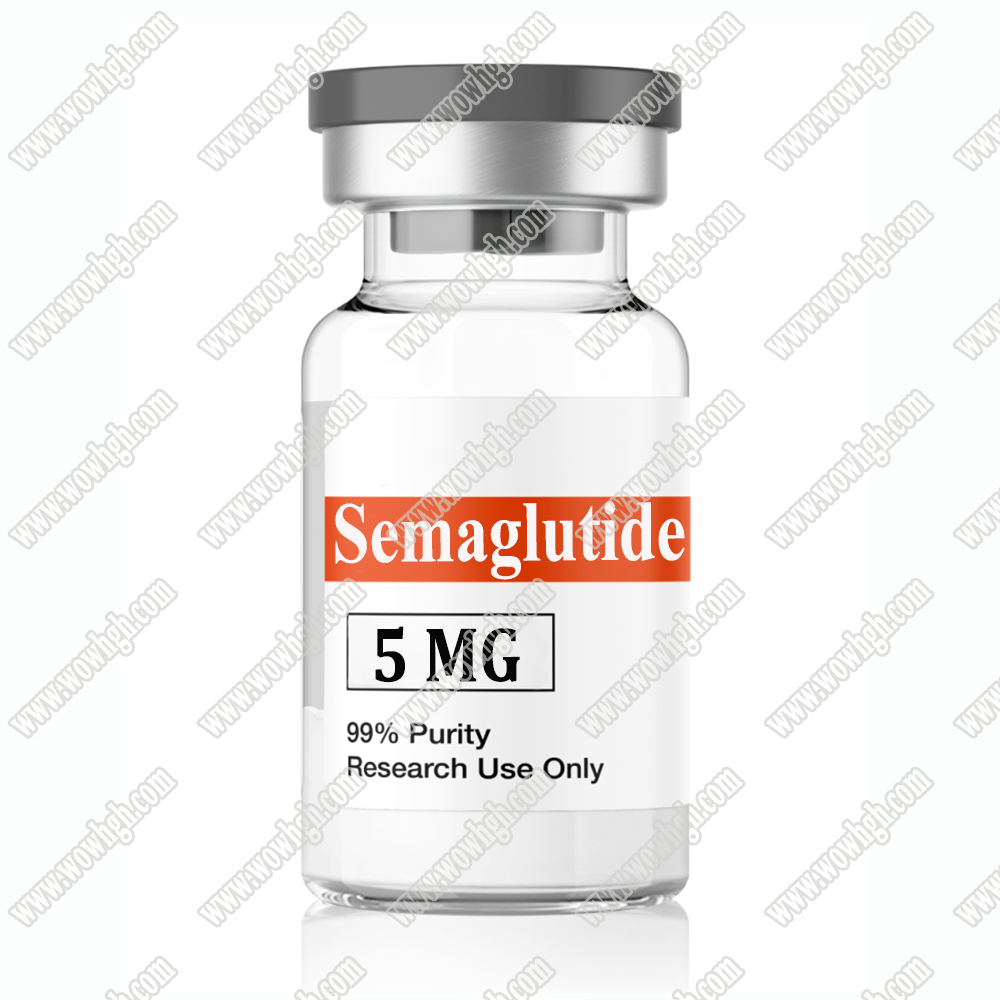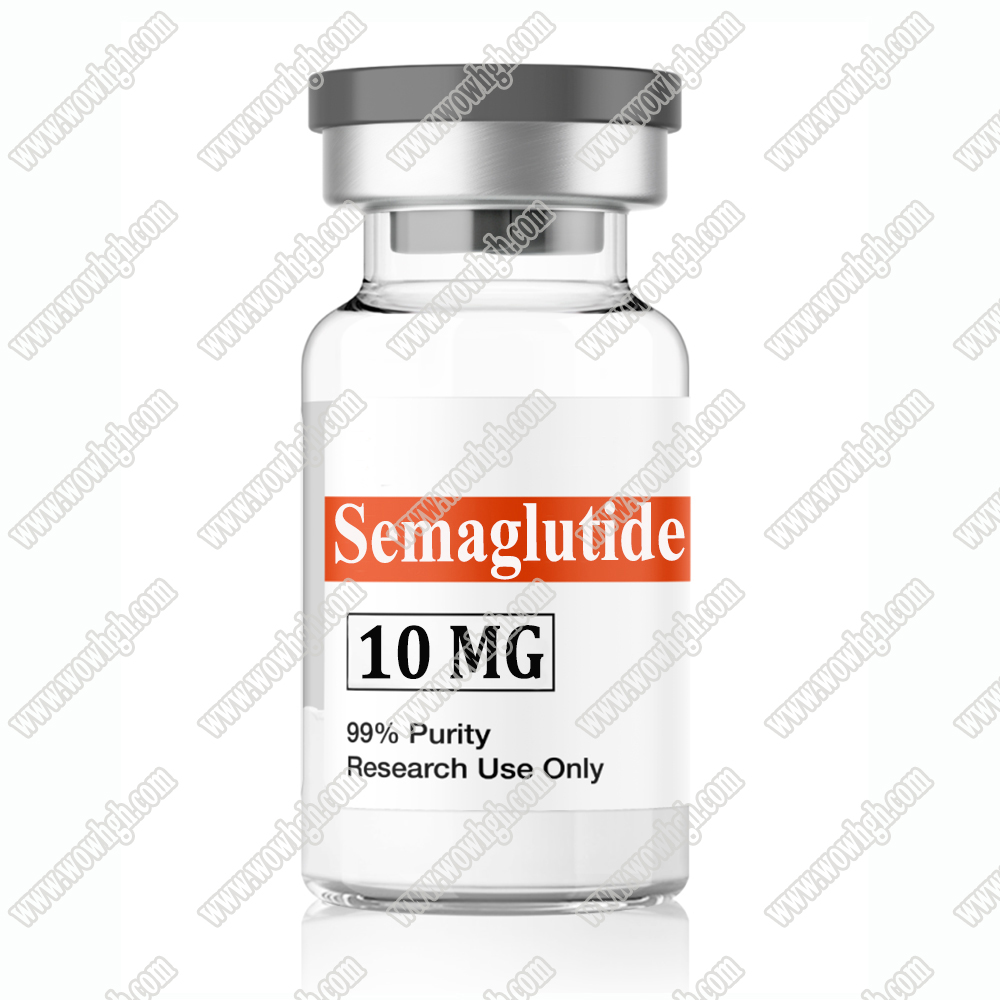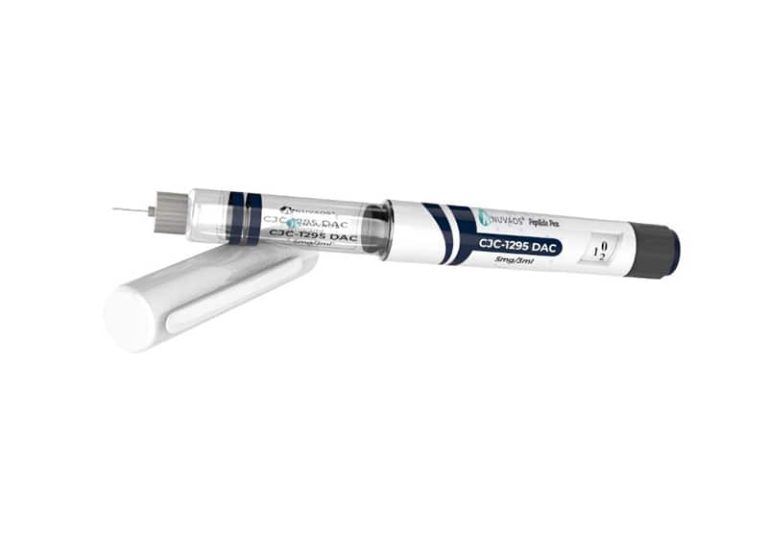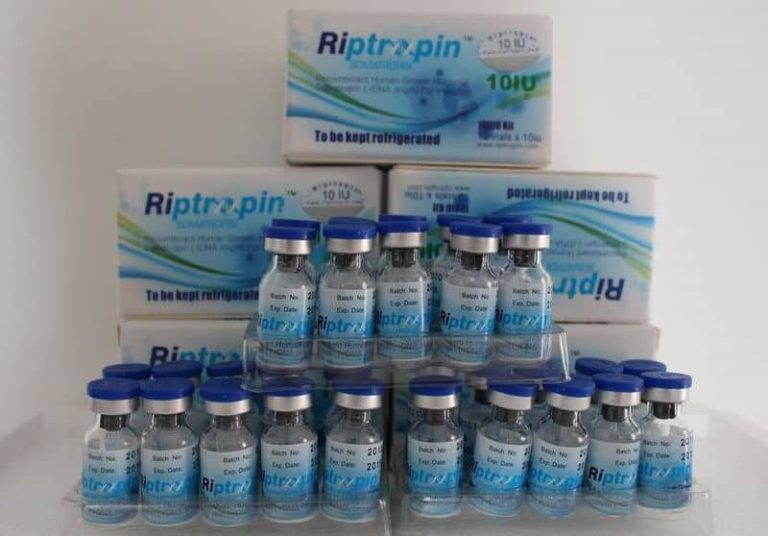More recently, Semaglutide has grown in popularity as an injectable weight-loss medication. The injection imitates GLP1 – a naturally occurring peptide in your body – which is released after you eat and signals to your brain that you are full. It also slows the rate at which the stomach empties after eating, which leads to feelings of fullness for longer.
Semaglutide is derived from the naturally occurring peptide GLP-1, which is known to lower blood sugar levels and boost insulin production. Semaglutide is a GLP-1 agonist and works by increasing insulin release, lowering the amount of glucagon released, delaying gastric emptying and reducing appetite.
Semaglutide injection is used to treat type 2 diabetes. It is used together with diet and exercise to help control your blood sugar. This medicine is also used to lower the risk of heart attack, stroke, or death in patients with type 2 diabetes and heart or blood vessel disease.
Semaglutide GLP-1 Analogue
- Manufacturer: Peptides lab.
- Since : 2022
- Purity : >99%
- Package :2mg/5mg/10mg/vials * 10vials * 1kits
- Price: $80 ~ $360
- Minimum Order:1 kits
- Payment : Bitcoin (Cryptocurrency), Paypal, T.T(Domestic bank transfer),W.U, Payoneer
- Shipping country : US,UK,EURO Country ,【Canada and Australia (confirm the seller)】
- Delivery: 100% delivery in 5-15 days
- Recommended:5 star
- Shop :
What Is Semaglutide?
Semaglutide peptide is a synthetic glucagon-like peptide-1 (GLP-1) analog. GLP-1 peptide is an endogenous weight loss peptide hormone containing 30 amino acids. The primary potential of this compound is to enhance insulin production, reduce blood sugar levels, and conserve the pancreatic beta cells by stimulating insulin gene transcription. Additionally, the compound delays apparent gastric emptying and hence may suppress appetite. GLP-1 appears to profounding affect the most critical organs, including the heart, kidney, lungs, and liver. Semaglutide, as a GLP-1 receptor agonist, may possibly reduce insulin levels and glucose, reduce appetite, and induce weight loss.
How Semaglutide Works ?
Semaglutide is a glucagon-like peptide-1 (GLP-1) agonist, This injectable medication activates your body’s GLP-1 receptors, mimicking the natural hormone.
Semaglutide works to lower high blood sugar by increasing the amount of insulin that is released, lowering the amount of glucagon released and by delaying gastric emptying. The result is a reduced appetite, improved control over blood sugar levels, and decreased risk of serious cardiovascular events. By seamlessly incorporating into your routine, you can witness a significant improvement in your health metrics.Semaglutide also controls appetite and so helps you reduce the amount of food that you want to eat.
Semaglutide Effects or Medical uses
- Regulates Blood Sugar
Semaglutide is indicated as an adjunct to diet and exercise to improve glycemic control in adults with type 2 diabetes.
Semaglutide is a glucagon-like peptide-1 receptor agonist. It increases the production of insulin, a hormone that lowers the blood sugar level.It also appears to enhance growth of β cells in the pancreas, which are the sites of insulin production. It also inhibits glucagon, which is a hormone that increases blood sugar. - Weight loss Shuts Down Hunger Cues
Whenever we eat food, the foods we’re eating actually activate the appetite centers in the brain. Under normal conditions, we’d feel full when we’re done eating. This happens due to the release of a gut hormone called GPL-1 that essentially shuts down the brain’s hunger cues. Some people don’t experience these cues because their bodies aren’t producing the levels of GPL-1 needed to make them feel full and satisfied.
When semaglutide is injected, it mimics the GLP-1 hormone to affect the receptors that “shut down” feelings of hunger. That means that you’re experiencing complete fullness and satisfaction when either not eating or eating much less food than normal. Studies have found that taking semaglutide is associated with fewer food cravings, less hunger and better control of food intake. Taking semaglutide also results in a lower preference for high fat foods.
For many people, using semaglutide weekly marks the end of cravings, frenzied eating, and constant feelings of hunger. may decrease appetite and cause weight loss.
Other uses for this medicine
This medication may be prescribed for other uses; ask your doctor or pharmacist for more information.
Semaglutide Side Effects
Semaglutide injection may cause side effects. Tell your doctor if any of these symptoms are severe or do not go away:
- nausea
- vomiting
- diarrhea
- abdominal pain
- constipation
- heartburn
- burping
IMPORTANT WARNING: Some side effects can be serious. If you experience any of these symptoms call your doctor immediately or get emergency medical treatment:
- ongoing pain that begins in the upper left or middle of the stomach but may spread to the back, with or without vomiting
- rash; itching; swelling of the eyes, face, mouth, tongue, or throat; or difficulty breathing or swallowing
- decreased urination; or swelling of legs, ankles, or feet
- vision changes
- fainting or dizziness
- pain in upper stomach; yellowing of skin or eyes; fever; or clay-colored stools (in those receiving semaglutide [Wegovy] for management of weight loss)
- rapid heartbeat
Semaglutide injection may cause other side effects. Call your doctor if you have any unusual problems while using this medication.
If you experience a serious side effect, you or your doctor may send a report to the Food and Drug Administration’s (FDA) MedWatch Adverse Event Reporting program online.
Before Using Semaglutide
What Special Precautions Should I Follow Before Taking Semaglutide Injection?
- tell your doctor if you have or have ever had pancreatitis (inflammation of the pancreas), diabetic retinopathy (damage to the eyes caused by diabetes), gallbladder disease, or kidney disease. Also tell your doctor if you have recently had diarrhea, nausea, or vomiting or if you cannot drink liquids by mouth, which may cause dehydration (loss of a large amount of body fluids).
- tell your doctor if you plan to become pregnant. Your doctor may tell you to stop using semaglutide injection for 2 months before a planned pregnancy.
- tell your doctor if you are pregnant or are breastfeeding. If you become pregnant while using semaglutide injection, call your doctor.
- ask your doctor what to do if there is a large change in your diet, exercise, or weight; or if you get sick, develop an infection or fever, experience unusual stress, or are injured. These changes and conditions can affect your blood sugar and the amount of semaglutide injection you may need.
- tell your doctor and pharmacist if you are allergic to semaglutide, albiglutide (Tanzeum; no longer available in the US), dulaglutide (Trulicity), exenatide (Bydureon, Byetta), liraglutide (Saxenda, Victoza), lixisenatide (Adlyxin, in Soliqua), any other medications, or any of the ingredients in semaglutide injection. Ask your pharmacist or check the Medication Guide for a list of the ingredients.
- tell your doctor and pharmacist what prescription and nonprescription medications, vitamins, nutritional supplements, and herbal products you are taking or plan to take. It is especially important to tell your doctor about all the medications you take by mouth because semaglutide may change the way your body absorbs these medications.
- you should know that your mental health may change in unexpected ways and you may become suicidal (thinking about harming or killing yourself or planning or trying to do so) while you are using semaglutide injection for weight loss. You, your family, or your caregiver should call your doctor right away if you experience any of the following symptoms: depression; talking or thinking about wanting to hurt yourself or end your life; withdrawing from friends and family; preoccupation with death and dying; or any other unusual changes in behavior or mood. Be sure that your family or caregiver knows which symptoms may be serious so they can call the doctor if you are unable to seek treatment on your own.
Why Semaglutide Choice For Weight Loss ?
Helps You Feel Fuller–There’s also a second way that semaglutide makes it easier to lose weight by eating less. Semaglutide injections slow down the movement of food through the stomach. This gives your body more time to feel fuller on fewer calories. In addition, semaglutide injections help the pancreas release the proper amount of insulin to correspond with blood-sugar levels to create a stable, non-shaky feeling.
The end result is a strong reduction in appetite that allows you to feel full and energized while eating much less. It’s like going on a diet without actually realizing that you’re dieting.
How Semaglutide Work In Bodybuilding?
Recent studies suggest that Semaglutide may have potential benefits for those looking to build muscle.
Semaglutide appetite-suppressing properties helpful in bodybuilding.
Semaglutide is primarily used as a treatment for type 2 diabetes.GLP-1 is a hormone that promotes insulin secretion, slows digestive processes, and suppresses appetite. By reducing hunger pangs, it may allow for more control over diet, a critical aspect of bodybuilding. A more controlled diet could mean more precise calorie and macronutrient intake, potentially offering you an edge in maximizing muscle mass and minimizing body fat.
GLP-1 also aids muscle recovery and helps reduce muscle inflammation post workout.increase muscle growth
Semaglutide helps to increase your insulin sensitivity. Why is this important for muscle growth? Well, insulin plays a key role in stimulating protein synthesis and halting protein breakdown in your muscles.
- The science is quite straightforward:
- When insulin sensitivity is increased, your body becomes more efficient at utilizing glucose.
- High insulin sensitivity allows for more glucose to be transported into your muscle cells, providing your muscles with the energy they need to grow.
- Balanced insulin levels help retain muscle during a cut and prevent muscle breakdown
And of course this compound is perfect for burning fat. Various studies have shown that GLP-1 Receptor Agonists can lead to significant weight loss. Lower body fat percentages generally lead to better muscle definition.
Benefits And side effects of Semaglutide in Bodybuilding
Considered a potential powerhouse in the bodybuilding community, semaglutide offers several benefits that are hard to overlook. It’s not all sunshine and rainbows, though, as this substance also presents risks worth pondering. So let’s dive in and take a balanced look at the pros and cons.
Benefits of Semaglutide in Bodybuilding
Firstly, this peptide can promote significant weight loss. This could help you get chiseled faster and more efficiently. Additionally, it has the ability to regulate your blood sugar levels, reducing the risk of energy crashes during intense workouts. Plus, it suppresses appetite, which could help with diet control and calorie restriction during the cutting phase.
A more impressive advantage of semaglutide lies in its potential to improve cardiovascular health. Science has been indicating that it could lower cholesterol levels and reduce blood pressure, making it a potentially heart-healthy ally in your bodybuilding journey.
side effects of Semaglutide in Bodybuilding
On the flip side, it’s crucial to be aware of the potential downsides. One of the main drawbacks of it’s use in bodybuilding is its side effects. You could experience nausea, stomach discomfort, and even reduced kidney function, which isn’t ideal for anyone working hard in the gym.
Moreover, GLP-1 agonists may not be suitable for everyone. People with certain medical conditions, like pancreatitis, gallbladder problems, or alcoholism, should consult a healthcare professional before starting any kind of peptide therapy.
Remember, even though semaglutide can provide these possible benefits, it’s still a prescription medication. Make sure to talk with your doctor before making any drastic changes in your routine or strategy.
What Is Semaglutide Brand Product?
Wegovy, Ozempic, Rybelsus are the brand Semaglutide product,Each of the different brands of semaglutide (Wegovy, Ozempic, Rybelus) are FDA approved for different conditions.
Semaglutide Dosage
Different dosage levels and what to expect
Dosage
Different doses of semaglutide offer a variety of effects and potential side effects, requiring a tailored regime for every individual. Here, we break down the differences between 0.25mg, 0.5mg, 1mg, and 2mg doses per week, as well as provide recommendations about ramping up dosage over time to mitigate side effects.
Understanding Dose-Specific Implications
- 0.25mg per week: This is generally the starting dose, priming your body for higher doses. It’s lower concentration minimizes the risk of initial side effects, such as nausea and diarrhea.
- 0.5mg per week: Following successful toleration of the 0.25mg dose, a typical next step is to increase to the 0.5mg amount. At this level, you begin to experience considerable benefits, like blood sugar control and modest weight loss.
- 1mg per week: The 1mg dose is often the target for most patients aiming for sustained weight loss. This dosage level enhances the rate of weight loss while still maintaining diabetes control.
- 2mg per week: Currently used for weight management, the 2mg dose accelerates the pace of weight and fat loss. However, it also comes with a heightened risk for side effects and should be considered only under medical supervision.
Recommendations for Incremental Dosage Increase
Graduating from a lower dosage to a higher one should be a slow and considerate process to allow your body to adjust and minimize potential side effects.
Here are some broad suggestions for ramping up semaglutide dosage:
- Week 1-2: Begin with the lowest dose of 0.25mg once weekly. This allows your body to gradually accommodate the new medication and minimizes the initial side effect impact.
- Week 3-4: If you tolerate the 0.25mg dose well, increase to 0.5mg per week. Monitoring your body’s reactions is crucial during this phase.
- Week 5 onwards: Gradually raise the dosage to 1mg per week. Continue monitoring for side effects and adjust the dosage if necessary.
- Extended time frame: If you and your healthcare provider have agreed to try the 2mg dose for intensive weight management, ensure that you have tolerated the 1mg dose over an extended period first.
Concerning timing, it’s advisable to take your dosage at the same time each week. It’s not dependent on meals, thus gives you the flexibility to take it anytime suitable.
Let’s lay out some key points about using Semaglutide:
- Start with a low dose and ramp up over time
- The dosage is usually administered via a weekly subcutaneous injection
- It’s crucial to take the dosage at the same time each week.
How To Use Semaglutide?
Usual Adult Dose for Diabetes Type 2
Oral Tablets:
Initial dose: 3 mg orally once a day for 30 days; then 7 mg orally once a day
- Titration: If additional glycemic control is needed after receiving 7 mg/day for at least 30 days, may increase to 14 mg orally once a day
Maintenance dose: 7 to 14 mg orally once a day
Maximum dose: 14 mg/day (taking two 7 mg tablets to achieve a 14 mg dose is not recommended)
Subcutaneous Administration:
Initial dose: 0.25 mg subcutaneously once a week for 4 weeks, then 0.5 mg subcutaneously once a week
- If additional glycemic control is needed after at least 4 weeks receiving 0.5 mg dose subcutaneously once a week, may increase to 1 mg subcutaneously once a week
Maintenance dose: 0.5 to 1 mg subcutaneously once a week
Maximum dose: 1 mg/week
Switching between Subcutaneous Administration and Oral Tablets:
- Patients receiving 14 mg orally once a day can be transitioned to 0.5 mg subcutaneously once a week; subcutaneous administration should start after last oral dose
- Patients receiving 0.5 mg subcutaneously once a week can be transitioned to 7 or 14 mg orally once a day; oral therapy should start up to 7 days after last subcutaneous injection
- No equivalent oral dose is recommended to replace a subcutaneous dose of 1 mg weekly
Comments:
- Doses of 0.25 mg subcutaneously once a week and 3 mg orally once a day are intended for treatment initiation and are not effective doses for glycemic control.
- This drug has not been studied in patients with a history of pancreatitis; other antidiabetic therapies should be considered in these patients.
Uses:
- As an adjunct to diet and exercise to improve glycemic control in adults with type 2 diabetes mellitus
- To reduce the risk of major adverse cardiovascular events (cardiovascular death, non-fatal myocardial infarction or non-fatal stroke) in adults with type 2 diabetes mellitus and established cardiovascular disease
Usual Adult Dose for Cardiovascular Risk Reduction
Oral Tablets:
Initial dose: 3 mg orally once a day for 30 days; then 7 mg orally once a day
- Titration: If additional glycemic control is needed after receiving 7 mg/day for at least 30 days, may increase to 14 mg orally once a day
Maintenance dose: 7 to 14 mg orally once a day
Maximum dose: 14 mg/day (taking two 7 mg tablets to achieve a 14 mg dose is not recommended)
Subcutaneous Administration:
Initial dose: 0.25 mg subcutaneously once a week for 4 weeks, then 0.5 mg subcutaneously once a week
- If additional glycemic control is needed after at least 4 weeks receiving 0.5 mg dose subcutaneously once a week, may increase to 1 mg subcutaneously once a week
Maintenance dose: 0.5 to 1 mg subcutaneously once a week
Maximum dose: 1 mg/week
Switching between Subcutaneous Administration and Oral Tablets:
- Patients receiving 14 mg orally once a day can be transitioned to 0.5 mg subcutaneously once a week; subcutaneous administration should start after last oral dose
- Patients receiving 0.5 mg subcutaneously once a week can be transitioned to 7 or 14 mg orally once a day; oral therapy should start up to 7 days after last subcutaneous injection
- No equivalent oral dose is recommended to replace a subcutaneous dose of 1 mg weekly
Comments:
- Doses of 0.25 mg subcutaneously once a week and 3 mg orally once a day are intended for treatment initiation and are not effective doses for glycemic control.
- This drug has not been studied in patients with a history of pancreatitis; other antidiabetic therapies should be considered in these patients.
Uses:
- As an adjunct to diet and exercise to improve glycemic control in adults with type 2 diabetes mellitus
- To reduce the risk of major adverse cardiovascular events (cardiovascular death, non-fatal myocardial infarction or non-fatal stroke) in adults with type 2 diabetes mellitus and established cardiovascular disease
Usual Adult Dose for Weight Loss
Initial Dose Escalation Schedule:
- Weeks 1 through 4: 0.25 mg subcutaneously once a week
- Weeks 5 through 8: 0.5 mg subcutaneously once a week
- Weeks 9 through 12: 1 mg subcutaneously once a week
- Weeks 13 through 16: 1.7 mg subcutaneously once a week
Maintenance Dose:
- Week 17 and onward: 2.4 mg subcutaneously once a week
Dosing Considerations:
- If dose escalation is not tolerated, consider delaying dose escalation for 4 weeks
- If the maintenance dose of 2.4 mg once a week is not tolerated, the dose can be temporarily decreased to 1.7 mg once a week for a maximum of 4 weeks
- After 4 weeks, increase dose back to 2.4 mg once a week; discontinue therapy if the patient cannot tolerate the maintenance dose of 2.4 mg once a week
Comments:
- or patients with type 2 diabetes, blood glucose should be monitored at baseline and during treatment.
- This drug should not be coadministered with other semaglutide-containing products or with any other GLP-1 receptor agonist.
- The safety and effectiveness of using this drug in combination with other weight loss products have not been established.
- This drug has not been studied in patients with a history of pancreatitis.
Uses:
As an adjunct to a reduced calorie diet and increased physical activity for chronic weight management in adults with an initial body mass index (BMI) of 30 kg/m2 or greater, OR 27 kg/m2 or greater in the presence of at least one weight-related comorbid condition such as hypertension, type 2 diabetes mellitus, or dyslipidemia.
Renal Dose Adjustments
No adjustment recommended
Liver Dose Adjustments
No adjustment recommended
Dose Adjustments
Concomitant use of an insulin secretagogue (e.g., sulfonylurea) or insulin increases the risk of hypoglycemia, including severe hypoglycemia
- A reduced dose of insulin secretagogue or insulin may be needed
Precautions
US BOXED WARNING: Risk of Thyroid C-Cell Tumors:
- In rodents, this drug causes dose-dependent and treatment-duration dependent thyroid C-cell tumors at clinically relevant exposures. It is unknown whether this drug causes thyroid C-cell tumors, including medullary thyroid carcinoma (MTC) in humans, as the human relevance has not been determined.
- This drug is contraindicated in patients with a personal or family history of MTC and in patients with Multiple Endocrine Neoplasia syndrome type 2 (MEN 2).
- Counsel patients regarding the risk of MTC and inform them of symptoms of thyroid tumors (e.g., a mass in the neck, dysphagia, dyspnea, persistent hoarseness). Routine monitoring of serum calcitonin or using thyroid ultrasound is of uncertain value for early detection of MTC in patients receiving this drug.
CONTRAINDICATIONS:
- A prior serious hypersensitivity reaction to semaglutide or to any product excipients; serious
hypersensitivity reactions including anaphylaxis and angioedema have been reported (subcutaneous formulation)
- Hypersensitivity to active substance or any product components (oral formulation)
- Personal or family history of medullary thyroid carcinoma (MTC)
- Patients with Multiple Endocrine Neoplasia syndrome type 2 (MEN 2)
Safety and efficacy have not been established in patients younger than 18 years.
Consult WARNINGS section for additional precautions.
Dialysis
No adjustment recommended with ESRD; however, no specific data is available for dialysis
Other Comments
Administration advice:
Oral Tablets:
- Take orally with no more than 4 ounces of plain water at least 30 minutes before the first food, beverage, or other oral medications of the day; waiting less than 30 minutes or taking with food, beverages other than plain water will decrease the absorption of this drug; waiting more than 30 minutes to eat may increase the absorption of this drug
- Swallow tablet whole, do not split, crush or chew
- Taking two 7 mg tablets to achieve a 14 mg dose is not recommended
MISSED DOSE: If a dose is missed, skip the missed dose and resume regular schedule
Subcutaneous Injection:
- Administer subcutaneously once a week into the abdomen, thigh, or upper arm; use a different injection site each week when injecting in the same body region
- Administer on the same day each week; may give at any time of the day, with or without meals
- When administering with insulin, administer as separate injections; it is okay to give in the same body region, but the injections should not be adjacent to each other
- Never share a pen between patients, even if the needle is changed; do not reuse or share needles or syringes between patients as this presents a risk for transmission of blood-borne pathogens
How to Reconstitute Semaglutide?
1.Gather the Necessary Supplies
First things first, you’ll want to make sure you have everything you need at hand:
- The semaglutide vial
- A reconstitution needle
- An injection needle
- A vial of saline or the diluent provided by the manufacturer
- Alcohol swabs
- A clean, flat surface
Double-check that your supplies are not expired and are properly sealed before you begin.
2. Preparation of the Injection Site
Your injection site should be prepped to minimize the risk of infection. Here’s how you do it:
- Choose an injection site—typically the abdomen, thigh, or upper arm.
- Clean the area with an alcohol swab making a circular motion outward from the center. Let it air dry.
- Don’t touch the cleaned area again to keep it sterile.
3. Mixing the Medication
Mixing is crucial for the efficacy of your dose:
- Wipe the top of the semaglutide vial with an alcohol swab.
- Attach the reconstitution needle to the syringe and draw the prescribed amount of saline or diluent.
- Inject the diluent into the vial of semaglutide, aiming the stream of liquid at the vial’s wall to avoid excessive frothing.
- Gently swirl the vial to mix the solution — avoid shaking as it can cause bubbles.
Ensure the mixture is clear and free of particles before proceeding.
4. Administering the Injection
You’re now ready to administer the injection:
- Swap the reconstitution needle with the injection needle if they’re not the same.
- Invert the vial and draw the reconstituted semaglutide into the syringe.
- Flick the syringe gently to rise any air bubbles to the top and then expel them.
- Pinch the skin at the prepared injection site and insert the needle at the angle recommended by your healthcare provider.
- Push the plunger down slowly and steadily to administer the dose.
- Once done, release the skin and withdraw the needle.
Dispose of the needle safely in a sharps container. Always follow specific medical advice provided by your healthcare provider and refer to product labeling for exact details.
What Should I Do If I Miss A Semaglutide Dose?
MISSED DOSE for TYPE 2 DIABETES:
- If a dose is missed, administer as soon as possible within 5 days after the missed dose; if more than 5 days have passed, skip the missed dose and administer the next dose on the regularly scheduled day, resume regular once a week dosing
- Day of weekly administration may be changed as long as the time between doses is greater than 48 hours
MISSED DOSE for WEIGHT LOSS:
- If 1 dose is missed and the next scheduled dose is more than 2 days away (48 hours), administer as soon as possible
- If one dose is missed and the next scheduled dose is less than 2 days away (48 hours), do not administer the dose.; resume dosing on the regularly scheduled day of the week
- If more than 2 consecutive doses are missed, resume dosing as scheduled or, reinitiate following the dose escalation schedule, which may reduce the occurrence of gastrointestinal symptoms associated with reinitiation of treatment
What Happens If I Overdose?
In case of overdose, If you take too much Semaglutide, call your healthcare provider or seek medical advice promptly. Information is also available online at Poison Help If the victim has collapsed, had a seizure, has trouble breathing, or can’t be awakened, immediately call emergency services.
Semaglutide Storage &Disposal
Store the Medication Properly
- Before dilution,Store Semaglutide in a refrigerator at 2°C to 8°C (36°F to 46°F) and avoid frozen.
- If needed, each single-dose pen or single-dose vial can be stored unrefrigerated at temperatures not to exceed 30ºC (86ºF) for up to 21 days.
- Once you’ve mixed it, you’ve got a time limit. Use the medication within 30 days, or it’s no longer good to go.
- Do not freeze Semaglutide. Do not use Semaglutide if frozen.
- Store Semaglutide in the original carton to protect from light.
Dispose of Used Needles and Syringes Safely
You’re done with your injection, but you’re not done with the process. Needles and syringes pose a risk if disposed of carelessly. Securely place them in a sharps disposal container immediately after use. No sharps container on hand? You can use a heavy-duty plastic container as a temporary fix. Just make sure it’s appropriately sealed and labeled to prevent accidental pokes. Remember to check local guidelines for disposal; don’t just toss them in the trash.
Seek Medical Attention for Any Adverse Reactions
You’ve done everything right, but your body may still react unpredictably. If you notice anything off, particularly serious side effects like trouble breathing or severe abdominal pain, seek medical attention immediately. These aren’t just little hiccups—they can signify something more critical. Keep your healthcare provider’s info handy for quick reference in case things go south. They’ll need to know everything about the reaction to give you the best care.
What are similar medications to semaglutide?
Semaglutide belongs to the class of medications known as glucagon-like peptide-1 receptor agonists (GLP-1 agonists). There are several other GLP-1 agonists that are similar to semaglutide in terms of their mechanism of action and therapeutic use for the treatment of type 2 diabetes. Some commonly used GLP-1 agonists include:
- Liraglutide (Victoza): Liraglutide is another GLP-1 agonist that is approved for the treatment of type 2 diabetes. It shares similarities with semaglutide in terms of efficacy in lowering blood glucose levels and promoting weight loss.
- Dulaglutide (Trulicity): Dulaglutide is a once-weekly GLP-1 agonist used for the management of type 2 diabetes. It has a similar mechanism of action to semaglutide and has demonstrated efficacy in improving glycemic control and promoting weight loss.
- Exenatide (Byetta, Bydureon): Exenatide is available in two formulations: immediate-release (Byetta) for twice-daily dosing and extended-release (Bydureon) for once-weekly dosing. It is also a GLP-1 agonist used in the treatment of type 2 diabetes.
- Albiglutide (Tanzeum): Albiglutide is a once-weekly GLP-1 agonist that was previously available for the treatment of type 2 diabetes. However, it has been withdrawn from the market in some countries.
- Lixisenatide (Adlyxin): Lixisenatide is a GLP-1 agonist administered once daily for the management of type 2 diabetes. It has a similar mechanism of action to semaglutide and other GLP-1 agonists.
- Tirzepatide (Tirzepatide): Tirzepatide is a It is a dual glucose-dependent insulinotropic polypeptide (GIP) and glucagon-like peptide-1 (GLP-1) receptor agonist..
These are just a few examples of GLP-1 agonists that are similar to semaglutide in terms of their mechanism of action and use for type 2 diabetes management. It’s important to note that the specific choice of GLP-1 agonist may depend on various factors such as individual
Semaglutide Summary
Diving into a deep exploration of the pros and cons of Semaglutide for bodybuilding, you’ve observed a mix of potential benefits and risks.
Being a prominent investigational treatment option for obesity, Semaglutide holds certain pros for bodybuilders. It potentially promotes significant weight loss while preserving muscle mass. By enhancing satiety and decreasing calorie intake, you could gain an edge in achieving a lean physique. And it doesn’t stop there—it’s also known for its ability to control blood sugar levels, helpful in a bodybuilder’s diet which may consist of high carb intakes.
On the flip side, it isn’t without downsides. You need to be cautious of potential side effects including nausea, abdominal pain, and changes in insulin levels. The drug isn’t approved for bodybuilding, so there’s little research on its long-term impact within this context.
In the end, it’s your health and goals that matter the most. Always consider not just the potential upsides but also the possible risks. Consult a healthcare professional before making an informed decision. Remember, achieving your fitness goals should never come at the cost of your overall health.
Semaglutide Reviews
The study reported an average weight loss of around 2.4 stone or 15.3kg was lost in the group of participants taking the drug, while those receiving the placebo (dummy drug) only lost an average of 0.4 stone or 2.6kg.
Moreover, within the group taking Semaglutide, 75% of those in the Semaglutide group lost over 10% of their body weight and more than 30% lost over 20% of their body weight.
The findings indicate that this may indeed represent a major breakthrough in improving the health of those living with obesity.
References : Learn more about Semaglutide
- “Semaglutide in Obesity: An Evidence-Based Review of the Potential Benefits and Risks.” https://www.ncbi.nlm.nih.gov/pmc/articles/PMC8270223/
- “Semaglutide for the Treatment of Type 2 Diabetes Mellitus: A Systematic Review and Meta-analysis.” https://www.ncbi.nlm.nih.gov/pmc/articles/PMC8211464/
- “Efficacy and safety of semaglutide versus sitagliptin after 56 weeks in participants with type 2 diabetes inadequately controlled with metformin monotherapy.” https://www.ncbi.nlm.nih.gov/pmc/articles/PMC8287852/
- “Semaglutide and Weight Loss: A Systematic Review and Meta-Analysis.” https://www.ncbi.nlm.nih.gov/pmc/articles/PMC7930679/
- “Semaglutide in Type 2 Diabetes Mellitus: A Review of the SUSTAIN Trial Program.” https://www.ncbi.nlm.nih.gov/pmc/articles/PMC6776813/
- FDA.gov Semaglutide: https://www.accessdata.fda.gov/drugsatfda_docs/label/2021/215256s000lbl.pdf
- Wegovy Information: https://www.novo-pi.com/wegovy.pdf
F.A.Q (Frequently Asked Questions)
How does semaglutide work for weight loss?
Semaglutide works by mimicking the effects of a hormone called GLP-1. This hormone makes you feel fuller after meals, so you eat less, which leads to body weight and fat loss. This is also beneficial for people with chronically high levels of blood sugar, as it helps in lowering these levels.
What are the benefits of semaglutide?
Semaglutide not only aids in body weight and fat loss but also helps to control low blood sugar levels. It’s beneficial for those who have difficulty losing weight through lifestyle changes alone. It also reduces the risk of heart disease. It’s essential to note that the benefits of semaglutide should be complemented with lifestyle changes including diet and exercise for more effectiveness.
How do I take semaglutide?
The dosage is usually administered as an under-the-skin injection once a week. Note: Always consult with your healthcare provider for personalized advice, as the information presented is for informational purposes only, and not a substitute for professional medical advice.
How does Wegovy contribute to weight loss?
Semaglutide helps you lose weight by making you feel fuller after eating. This sensation prompts you to eat less, which in turn leads to a decrease in body weight.
What are the potential risks with using semaglutide?
Like all medications, semaglutide has potential risks, including inflammation of the pancreas. It may also cause low blood sugar levels when used with other diabetic medication. Seek medical attention immediately if you experience any severe or unusual side effects.
What is the correlation between semaglutide and GLP-1?
Semaglutide works by mimicking the effects of a hormone called GLP-1. This hormone is produced in the intestine and the brain and is released after meals. It encourages the body to eat less by making one feel fuller, resulting in weight loss.
Does semaglutide get rid of excess fat?
Yes, semaglutide does help in reducing excess fat. It works by making you feel fuller which leads to less eating and weight loss. But it’s also important to maintain a balanced diet and exercise regularly along with the semaglutide treatment.
Is semaglutide used to treat types of diabetes?
Yes, it is used to treat type 2 diabetes. It lowers blood sugar levels by mimicking the effects of a hormone called GLP-1. It’s also been found to aid in weight loss and reduce the risk of heart disease in these patients.
Do I have to maintain a diet while using GLP-1 agonists?
Yes, it’s highly recommended to maintain a healthy eating lifestyle while using semaglutide. The medication works better when complemented with a healthy diet and regular exercise. Therefore, glp-1 receptor agonists are not a quick-fix remedy; weight loss results are more likely to be seen when combined with other lifestyle changes.








